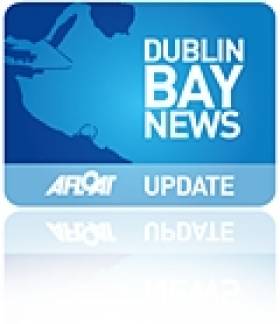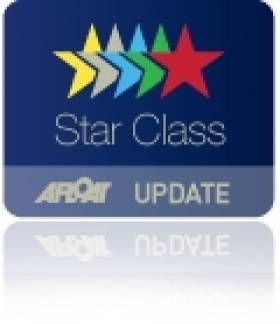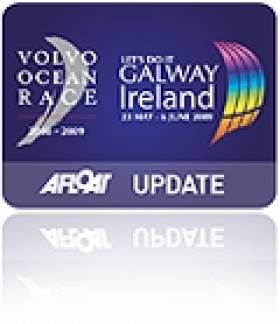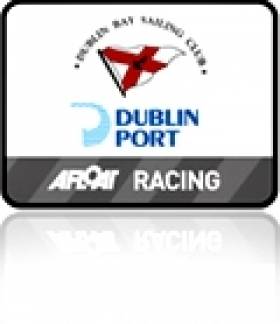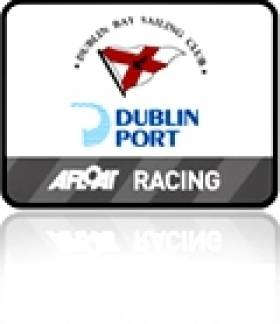Displaying items by tag: Bay
'Xtravagance' Keeps DBSC's Waterhouse Shield in the Family
#DUBLIN BAY – Tonight's Dublin Bay Sailing Club Annual Prizegiving 2011 is taking place at the Royal St George Yacht Club and among the top award winners is the X-34 Xtravagance skippered by Colin Byrne from the Royal Irish Yacht Club.
The prizegiving celebrates a season of successes on the bay and Afloat.ie published the roll of prizewinners in September and tonight over 40 trophies will be presented. See the DBSC 2011 Trophy Winners here.

Xtravagance skippered by Colin Byrne won the Waterhouse Shiled at tonight's DBSC Prizegiving for the top performance in a handicap class
Xtravagance won the overall IRC on Saturdays and Thursdays this season as well as the overall Thursday Echo (although the Royal Irish entry failed to make a clean sweep by two points in Saturday Echo).
Byrne's boat is a standard X-34. He sails with a purely amateur crew including his father, Philip, who is 81 years of age and his brothers among the crew. Xtravagance is the first Class 1 boat to win it for a number of years, it's also an award won on at least two occasions in the 1990s by his father in his yacht Growl Tiger.
Shifty Harbour Conditions for DMYC Frostbite Races
#DMYC FROSTBITE – Although the strong winds put some doubt about yesterday's in harbour sailing at Dun Laoghaire the second race of the DMYC Frosbites got away on schedule in spite of the very shifty conditions.

Hugh Butler crewing for Graeme Grant on their way to winning the Fireball Class in yesterday's DMYC Frostbite race in Dun Laoghaire Harbour Photo: Bob Hobby
Dublin Bay Sailing Club IDRA 14 Champions Frank Hamilton and Jenny Byrne (DMYC) were the winners of the Portsmouth Yardstick (PY) handicap dinghy fleet. The Royal St. George's Theo Lyttle won the Laser class with the top prize in the high performance Fireball dinghy going to Graeme Grant and Hugh Butler (RStGYC).

Monica Lee sailing upwind in her Supernova dinghy during yesterday's DMYC Frosdtbite race in Dun Laoghaire Harbour Photo: Bob Hobby
Stunning New Look to McLaughlin's Red Bay 650 RIB
There's a new look to Red Bay Boats all new look 6. 5 metre RIB and by all accounts from this week's Southampton Boat Show the Irish built performance RIB is a real head turner. They could've easily be dubbed the Show boat, 'Silver shadow' or then again 'White Lady' with her stunning tubes, stianless steel work, seating and white hull.
The Stormforce 650 is one of the most innovative RIBs produced by Redbay so far. The design came from a need for a standardised RIB of around 6.5 metres that could be built quicker and lighter in the County Antrim factory.
The 650 has one of the best handling hulls in its class, and we've seen her easily out-perform larger rival RIBs in rough weather. Although the basic hull is that of the Stormforce 6.5, the 650 features a redesigned bow and sheer line.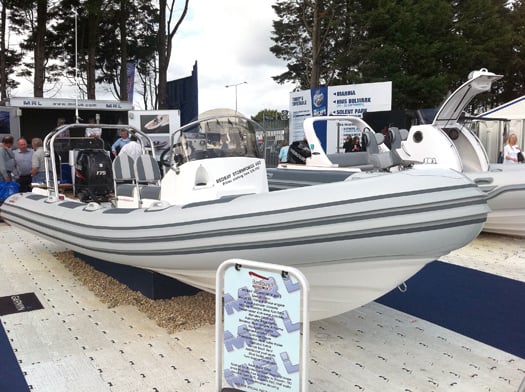
Master boat builder Tom McLaughlin was on the Southampton stand talking to Rib enthusiasts from across Ireland and the UK. The Red Bay name is now synonymous with heavy weather Ribbing and the boats have a reputation for their safety and comfort in big seas.
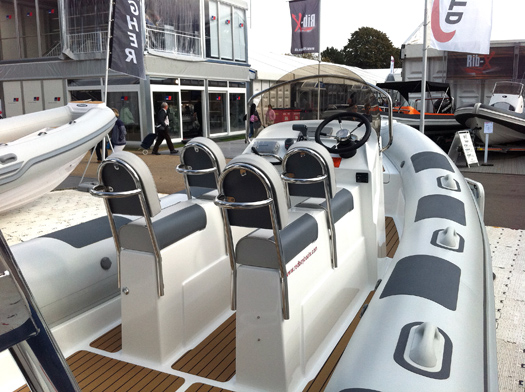
The 650 features a fully moulded internal deck. This gives a a fresh clean appearance. It also makes it easy to maintain. The 650 features a standard 4 seater side by side console and bow locker. The deck can be either finished in a quality non-slip coating or as in the case of the Show boat above with an in tek-deck.
It is fitted with a 175hp Suzuki 4-stroke outboard, 4-seater console, Garmin 750s touchscreen chartplotter, Garmin 100i DSC VHF, teak-decking, LED navigation lights.
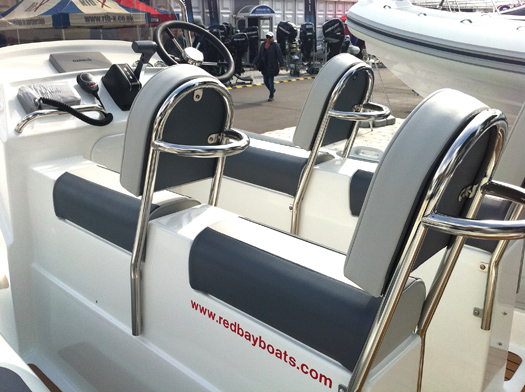
Italian Victory, Ireland Fourth at Star European Championships
Another first place in the penultimate race for Italians Diego Negri and Enrico Voltolini sealed their series-long domination and overall victory at the Star European Championship (2nd-10th September) at Dun Laoghaire yesterday. Irish Olympic campaigners Peter O'Leary and Dvid Burrows finished an impressive fourth overall in the 27-boat fleet.
Photos on the Afloat Gallery by Gareth Craig HERE.
Light and shifty conditions followed by a sea breeze completed the regatta that delivered a full range of conditions for the 27-boat fleet from 18 nations.
Negri and Voltolini kept their form for a fourth race win and typically enjoyed a comfortable lead at the finish of race seven. For the crews chasing the runner-up podium positions, the breeze proved as challenging as it has been all week, this time dying to a near calm on the final run before filling gently on the left hand-side side of the course catching the unwary, notably Guillaume Florent and Pascal Rambeau who had been vying with the Italian leaders for first place.
A wait followed for the eighth and final race of the week but only after a long wait for the sea breeze to build and settle. This took the fleet away from the now familiar area off Dun Laoghaire's West Pier and southwards towards this historic Dalkey Island side of Dublin Bay. After starting in ideal conditions of 18 knots, halfway through the race the breeze died completely to be followed by a 90-degree wind-shift that saw 2008 World Champion Mateusz Kusznierewicz and Dominik Zycki emerge with a substantial lead on the water and, having led from the outset were confirmed as second overall runners-up. Negri and Voltolini had already retired as their position was no better than their already discarded eighth in race six and were busy packing their boat as the final ended.
Irish hopes of a podium result on home waters were denied to London 2012 Olympic contenders Peter O'Leary and David Burrows who placed fourth in the last race but a ninth earlier in the day left them fourth overall as Canada's Richard Clarke and Tyler Bjorn took third place.
Star European Championship 2011 at Royal St. George YC, Dun Laoghaire, Ireland
(Final overall after eight races):
1st ITA Diego Negri & Enrico Voltolini
2nd POL Mateusz Kusznierewicz & Dominik Zycki
3rd CAN Richard Clarke & Tyler Bjorn
4th IRL Peter O'Leary & David Burrow
5th NOR Eivind Melleby & Petter Morland Pedersen
6th POR Afonso Domingos & Frederico Melo
Dublin to Hamble in 24 Hours - Team Sanya's Video
One minute it's trips round the bay with Miss World, canapés at the Royal Irish Yacht Club and corporate hobnobbing in Dun Laoghaire. The next it's a wet and windy ride from Dublin to Hamble in 24 hours. It's the lot of the modern Volvo Ocean Race crew (helmets compulsory). Chinese-Irish race entry Team Sanya boss Mike Sanderson (a previous race winner) has called his exit from Dublin 'heinous'. Don't take our word for it tho, check his vid below:
Italians Lead, O'Leary/Burrows Third in Star Europeans
Ireland's Peter O'Leary and David Burrows lie third and only six points off the overall lead held by Italian's Diego Negri and Enrico Voltolini after the first two races of the Star European championships in Dun Laoghaire.
The staging of the Contintental Championship of the Olympic Class, in which Ireland has reasonable aspirations of taking an Olympic medal next year, is being run by the Royal St. George Yacht Club under Howth race officer David Lovegrove.
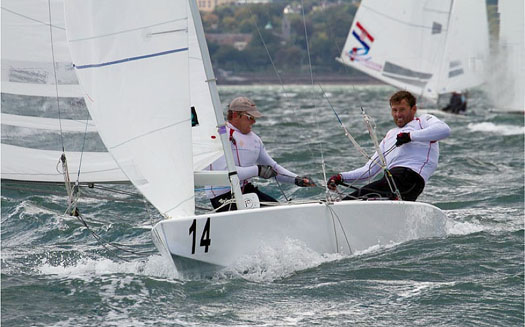
Star racing in big breeze on Dublin Bay yesterday. Photo: Gareth Craig. More pics on the Afloat Gallery here.
Ireland's other entry in the 27-boat fleet, Max Treacy and Anthnoy Shanks, of the host club lie 12th.
Second overall is France's Guillaume Florent and Pascal Rambeau. Britian's double Olympic gold medallists Iain Percy and Andrew Simpson, despite leading the first race for a time this afternoon, have posted an eighth and a seventh to lie eighth overall.
Racing on Dublin Bay continues tomorrow – under the threat of gales – until Friday.
Italians Negri and Voltolini delivered two consistent results of a race win and a second place in the 27-boat fleet from 17 nations.The Italians leaders were the 2006 European champions and overcame challenging post-frontal weather conditions that delivered 20-degree wind-shifts at times on an otherwise smooth race course off Seapoint on the south shore of Dublin Bay.
France's Guillaume Florent and Pascal Rambeau also had a consistent day with a second and third while the home fleet delivered a strong showing as Olympic veterans
Star European Championship 2011 at Royal St. George YC, Dun Laoghaire, Ireland
(Provisional overall standings after two races):
1st ITA Diego Negri & Enrico Voltolini
2nd FRA Guillaume Florent & Pascal Rambeau
3rd IRL Peter O'Leary & David Burrows
4th FRA Xavier Rohart Pierre & Alexis Ponsot
5th CAN Richard Clarke & Tyler Bjorn
6th POR Afonso Domingos & Frederico Melo
Lively Lady Wins DBSC Race on IRC and ECHO
Derek Martin's Beneteau 44.7 Lively Lady produced wins on IRC and ECHO in Dublin Bay Sailing Club's race this afternoon in medium winds that featured a long spinnaker run the length of Dublin Bay. Martin's Royal Irish club mate George Sisk was second on IRC in WOW, a new J122 design. Third was Denis Hewitt in another Royal Irish yacht, Tiamat, a Mark Mills design. Full DUBLIN PORT Dublin Bay Sailing Club Results for 20 AUGUST 2011below:
BENETEAU 31.7 Echo- 1. Attitude (D.Owens/T.Milner), 2. Levante (B.Leyden/M.Leahy), 3. Thirty Something (Gerry Jones et al)
BENETEAU 31.7 - 1. Prospect (Chris Johnston), 2. Thirty Something (Gerry Jones et al), 3. Levante (B.Leyden/M.Leahy)
CRUISERS 0 Echo - 1. Lively Lady (Derek Martin), 2. Tiamat (Denis Hewitt & al), 3. Tsunami (Vincent Farrell)
CRUISERS 0 - 1. Lively Lady (Derek Martin), 2. Wow (George Sisk), 3. Tiamat (Denis Hewitt & al)
CRUISERS 1 - 1. Gringo (Tony Fox), 2. Xtravagance (Colin Byrne), 3. Contango (Barry Cunningham)
CRUISERS 1 Echo - 1. Powder Monkey (C.Moore/M.Byrne), 2. Indecision (Declan Hayes et al), 3. Contango (Barry Cunningham)
CRUISERS 2 Echo - 1. Peridot (Jim McCann et al), 2. Jester (Declan Curtin), 3. Bendemeer (L Casey & D Power)
CRUISERS 2 - 1. Peridot (Jim McCann et al), 2. Jawesome 11 (V.Kennedy/M.Dyke), 3. Bendemeer (L Casey & D Power)
CRUISERS 3 Echo - 1. Gung Ho (G & S O'Shea), 2. Pamafe (Michael Costello), 3. Jammie Dodger (J.H & D.O'Neill)
CRUISERS 3 - 1. Gung Ho (G & S O'Shea), 2. Asterix (Counihan/Meredith/Bushell), 3. Jammie Dodger (J.H & D.O'Neill)
FIREBALL Race 1- 1. Licence to Thrill (Louis Smyth), 2. Goodness Gracious (Louise McKenna), 3. No Name (B McGuire)
FIREBALL Race 2- 1. Licence to Thrill (Louis Smyth), 2. Goodness Gracious (Louise McKenna), 3. Samphire (Marguerite O'Rourke)
FLYING FIFTEEN Race 1- 1. Kooigjug (K Dumpleton), 2. Rollercoaster (Tom Murphy), 3. Deranged (C.Doorly)
FLYING FIFTEEN Race 2- 1. Mellifluence (Tom Leonard), 2. Deranged (C.Doorly), 3.Frequent Flyer (D Mulvin)
GLEN - 1. Glenluce (D & R O'Connor), 2. Pterodactyl (R & D McCaffrey), 3. Glenshesk (L.Faulkner et al)
IDRA 14 FOOT Race 2- 1. Dunmoanin (Frank Hamilton), 2. Squalls (Stephen Harrison), 3. Doody (J.Fitzgerald/J.Byrne)
IDRA 14 FOOT Race 1- 1. Squalls (Stephen Harrison), 2. Dunmoanin (Frank Hamilton), 3. Dart (Pierre Long)
MERMAID Race 1- 1. Jill (P.Smith/P.Mangan), 2. Aideen (B.Martin/D.Brennan), 3. Kim (D Cassidy)
MERMAID Race 2- 1. Jill (P.Smith/P.Mangan), 2. Kim (D Cassidy), 3. Aideen (B.Martin/D.Brennan)
PY CLASS Race 1- 1. P Keane (Laser 1), 2. N O'Toole (Laser), 3. R Tate (Laser)
PY CLASS Race 2- 1. Yvonne Gordon (Laser Radial), 2. R Tate (Laser), 3. Desmond McCarthy (Laser 1)
RUFFIAN 23 - 1. Diane ll (Bruce Carswell), 2. Ruff N Ready (Ann Kirwan et al), 3. Alias (D.Meeke/M.McCarthy)
SHIPMAN - 1. Whiterock (Henry Robinson), 2. Gusto (C Heath), 3. Curraglas (John Masterson)
SIGMA 33 - 1. White Mischief (Timothy Goodbody), 2. Leeuwin (H&C Leonard & B Kerr), 3. Pippa lV (G.Kinsman/K.Blake/M.O'Brien)
SQUIB Race 2- 1. Kookaburra (P & M Dee), 2. Nimble (Brian O'Hare), 3. Little Bird (N Barnwell)
SQUIB Race 1- 1. Why Not (Derek & Jean Jago), 2. Little Bird (N Barnwell), 3. Nimble (Brian O'Hare)
WHITE SAIL CRUISERS Echo- 1. Zephyr (R Cahill-O'Brien), 2. Arwen (Philip O'Dwyer), 3. Nirvana (Bernard Neeson)
WHITE SAIL CRUISERS - 1. Arwen (Philip O'Dwyer), 2. Vespucci (S & K O'Regan), 3. Zephyr (R Cahill-O'Brien)
30 Boats Expected for Dun Laoghaire Fireball Dinghy Nationals
An initial review of the commitments and promises to contest the Fireball Nationals, hosted by Dun Laoghaire Motor Yacht Club, over the weekend of 26 – 28 August, conducted last Tuesday night after DBSC racing suggests that a fleet in the mid-thirties is possible.
Of course this means that all those people who have had recent contact with Neil Colin about sailing the event will have to deliver on their promises to be there.
In a year when our sailing programme has had to accommodate a two-week Worlds in Sligo, the prospect of a 30+ fleet is very exciting.
Nine races are programmed for the 3 days and Neil Colin, who is wearing two hats – DMYC representative and Fireball Committee member – appears to have all the organisational boxes ticked. The keelboat fraternity also has an event over the same weekend in Dublin Bay – the Cruiser Challenge.
In the Gold fleet there will as always be a queue of teams looking for the podium places. The three regattas sailed thus far this season have each had different winners – Graeme Grant & Francis Rowan in Carlingford, Noel Butler & Stephen Oram in Dun Laoghaire and Simon McGrotty & Ruari Grimes in Ballyholme. However, there are other combinations who have also featured in the 1-2-3 with Barry McCartin/Conor Kinsella getting onto the podium in two of these regattas, Kenny Rumball & Seamus Moore coming good in Belfast Lough, Francis Rowan & Conor taking the Volvo Dun Laoghaire Regatta, Diana Kissane taking a podium place in Dun Laoghaire as well as Andy Boyle.
In Belfast Lough Messrs Bracken & O'Hara were starting to show a return to the sort of form that made them regular occupiers of podium places in the recent past. Louis Smyth has also been showing a good turn of form as well. Frank Miller/Grattan Donnelly took a race win in Belfast Lough and have shown on Tuesday nights in DBSC racing that when they get the "bit between their teeth" they can be just as competitive as anyone.
The Silver fleet racing has also been very good this year and with new combinations coming into the Class as a consequence of the Worlds, there should be good competition in Dun Laoghaire for these combinations. The two Bens – Malone and Scallan showed their mettle in Sligo with the former also taking the Silver fleet prize in Carlingford. Cearbhall Daly & Martina Michels took over that mantle at the Dun Laoghaire event, while Hannah Showell & Margaret Casey won in Ballyholme. Marie Barry has featured strongly in this year's Silver fleet and will be breaking in a new helm for the Nationals! Mary Chambers & Brenda McGuire have upped their game considerably since they embarked on the Silver Fleet training in Killaloe and Dun Laoghaire in 2010, even going so far as to upgrade their boat to make themselves even more competitive. We have also seen some new talent coming into this fleet since the Worlds – new owners of Kenny Rumball's 14962 - who have confirmed their intention to sail the Nationals.
The challenge to those we have been missing this year is to see how they match up to these new combinations. For a variety of reasons, personal and work-related a number of people have been conspicuous by their absence for the circuit this year and that is understandable. The idea behind a Dublin Bay Nationals this year was to improve the accessibility and cost of the Nationals in a year when most people were expected to spend time in Sligo.
The initial assessment of the entry last Tuesday night would appear to suggest that decision has been vindicated.
WOW Makes Her Mark in Breezy DBSC Thursday Race
In a great turnout for the Dublin Bay fleet prior to the August Bank holiday, George Sisk's new J111 WOW chalked up another win in IRC Zero in Cruisers One. Vincent Farrell's Tsunmai was second. Sisk's club mate Colin Byrne from the Royal Irish sailing X-travangance was the IRC winner in the Cruisers one division. The full Dublin Bay DUBLIN PORT Dublin Bay Sailing Club Results for 28 JULY 2011are below:
BENETEAU 31.7 - 1. Levana (Jean Mitton), 2. Prima Nocte (Patrick Burke), 3. Magic (D.O'Sullivan/D.Espey)
BENETEAU 31.7 Echo- 1. Prima Nocte (Patrick Burke), 2. Attitude (D.Owens/T.Milner), 3. Kernach (Eoin O'Driscoll)
CRUISERS 0 - 1. Wow (George Sisk), 2. Tsunami (Vincent Farrell)
CRUISERS 1 - 1. Xtravagance (Colin Byrne), 2. Adrenalin (Joe McDonald), 3. Something Else (J.Hall et al)
CRUISERS 1 Echo - 1. Xtravagance (Colin Byrne), 2. Something Else (J.Hall et al), 3. Jetstream (Peter Redden)
CRUISERS 2 Echo - 1. Peridot (Jim McCann et al), 2. Graduate (D O'Keeffe), 3. White Lotus (Paul Tully)
CRUISERS 2 - 1. Peridot (Jim McCann et al), 2. Graduate (D O'Keeffe), 3. Jawesome 11 (V.Kennedy/M.Dyke)
CRUISERS 3 - 1. Supernova (K.Lawless et al), 2. Upd8 (Whelan/McCabe/Carey), 3. Gung Ho (G & S O'Shea)
CRUISERS 3 Echo - 1. Taiscealai (Brian Richardson et al), 2. Upd8 (Whelan/McCabe/Carey), 3. Supernova (K.Lawless et al)
DRAGON - 1. Diva (R.Johnson/R.Goodbody), 2. Phantom (D.Williams/P.Bowring), 3. Sir Ossis of the River (D Bergin)
FLYING FIFTEEN - 1. Hi Fibre (Michael McCambridge), 2. Flyer (Niall Coleman), 3. Snow White (Frank Burgess)
GLEN - 1. Glenmarissa (F.Elmes/W.Higgins), 2. Glencree (J.Bligh/H.Roche), 3. Glenshane (P Hogan)
RUFFIAN 23 - 1. Ruff N Ready (Ann Kirwan et al), 2. Shannagh (S.Gill/P.MacDiarmada), 3. Paramour (Larry Power et al)
SB3s - 1. Defiant (R.Hudson/J.Hooper), 2. Bom Chickawahwah (John O'Driscoll), 3. Probably (William Riordan)
SHIPMAN - 1. Curraglas (John Masterson), 2. Whiterock (Henry Robinson), 3. Twocan (David Freeman)
SIGMA 33 - 1. White Mischief (Timothy Goodbody), 2. Gwili Two (D.Clarke/P.Maguire), 3. Popje (Ted McCourt)
SQUIB - 1. Pintail (M Muldoon & B Stevens), 2. Little Bird (N Barnwell), 3. Absolutely Fabulous (N Kennedy/P Reilly)
WHITE SAIL CRUISERS Echo - 1. Persistence (C. Broadhead et al), 2. More Mischief (Eamonn Doyle), 3. Xerxes (Dan O'Neill)
WHITE SAIL CRUISERS - 1. Persistence (C. Broadhead et al), 2. Vespucci (S & K O'Regan), 3. Calypso (Howard Knott)



























